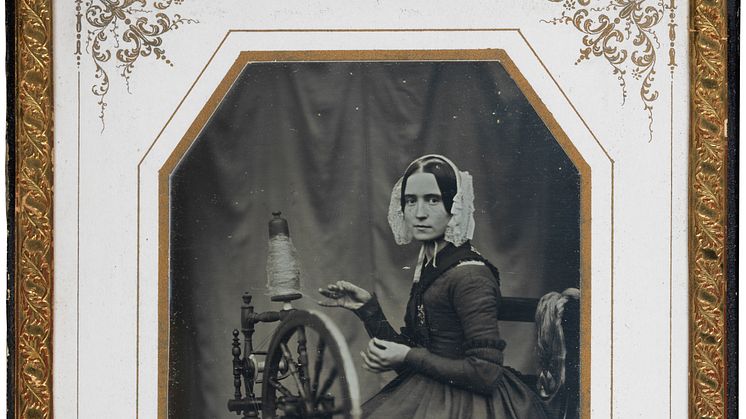
Press release -
Nationalmuseum acquires a daguerreotype by Johan Wilhelm Bergström
Nationalmuseum has acquired a central work in early Swedish photography, Johan Wilhelm Bergström's portrait of his wife Henriette Charlotta Catharina. The daguerreotype was probably created sometime in the mid-1840s, an era when Bergström was one of the very few portrait photographers working in Stockholm. The incredible sharpness and delicate composition of the image make this one of the daguerrotypist’s finest works.
In his day, Johan Wilhelm Bergström (1812–1881) was very much a self-made man in Stockholm’s mechanics industry. His father was a carpenter who worked in the foundry and mechanical workshop of the prominent inventor Samuel Owens. At the age of twelve, Bergström became apprenticed to a glassblower. After completing a master's test and coming of age, he opened his own workshop. It was one of the first workshops in Sweden to manufacture metal moulds for pressed glass. Over the years Bergström became a major entrepreneur in the management industry (gas, water, sewage), and his mechanical workshop manufactured everything from luminaires for the royal palaces to telegraph machines. For example, in 1866 the firm was commissioned to create the stair railings and balustrades (made of cast and bronzed zinc) for the staircase at Nationalmuseum.
Photography probably began as a private interest, but it also became part of Bergström's professional activities. In 1843, he acquired equipment for “light painting” through the bookseller Adolf Bonnier, who had purchased these supplies in Paris. The following year, examples of Bergström's daguerreotypes were displayed in Bonnier's bookshop in Norrbrobasaren. An advertisement in Aftonbladet describes “[p]ortraits [...] executed outside in a large, beautiful garden on Blasieholmen” during the summer months. The photographer was well aware of the importance of marketing and advertised extensively in the press. While many of his contemporaries travelled throughout Sweden seeking clients, Bergström instead remained in Stockholm and continued to run his mechanical workshop in parallel with his portrait photography business. In the mid-1840s, he completely dominated the city’s daguerreotype market. Ten years later, in 1854, Bergström stopped photographing and allowed a colleague to take over his studio.
In 1840, the “Glass Cutter-Fabricator” Johan Wilhelm Bergström married Henriette Charlotta Catharina Ronjon (1817–1891), the daughter of a workshop foreman. The marriage seems to have been happy and Johan Wilhelm wrote both tender letters and poems for his wife. She is the subject of some of his finest portraits.
In an advertisement published in 1845, Bergström announces that he has acquired new equipment and can now perform daguerreotypes “of the largest possible size”, which was just under 14.5 x 10 cm. His works in this format include a self-portrait now housed in the collections of Moderna Museet. Mrs Bergström was also portrayed in large format. The composition is painstakingly executed, down to the smallest detail. She is presented according to the ideals of her time – as a domestic woman, seated by a spinning wheel. The daguerreotype is razor sharp. One can even see the thin thread running from the wheel and between her hands. Her face is turned toward the photographer, and her intense gaze is directed at him. The viewer sees Mrs Bergström as her husband saw her.
Together with several other significant daguerreotypes by Johan Wilhelm Bergström, in the 20th century this portrait belonged to Helmer Bäckström. He was the first professor of photography at KTH in Stockholm and donated his collection to the Fotografiska museum, which is now part of Moderna Museet. However, the portrait of Henriette Charlotta Catharina Bergström came to take other paths. It is very gratifying that it has now been acquired by Nationalmuseum and added to the Swedish National Portrait Gallery. The Swedish National Portrait Gallery is the world's oldest national portrait gallery and is displayed at Gripsholm Castle. It contains over 5,000 portraits and is managed by Nationalmuseum.
Nationalmuseum receives no state funding with which to acquire design, applied art and artwork; instead the collections are enriched through donations and gifts from private foundations and funds. This acquisition has been made possible by a generous contribution from the Gripsholm Association of 1937.
Inventory number:
Johan Wilhelm Bergström, Henriette Charlotta Catharina Ronjon (1817–1891), Wife of the Photographer Johan Wilhelm Bergström, probably the 1840s. Daguerreotype. NMGrh 5206.
For more information
Eva-Lena Karlsson, curator, eva-lena.karlsson@nationalmuseum.se, +46 (0)8 5195 4430
Hanna Tottmar, Press Officer, press@nationalmuseum.se, +46 (0)8 5195 4400
Categories
Nationalmuseum is Sweden’s museum of art and design. The collections include paintings, sculpture, drawings and graphic art from the 16th century up to the beginning of the 20th century and the collection of applied art and design up to the present day. The museum building closed for renovation in 2013 and reopened in autumn 2018. During 2019 the museum had almost 850 000 visits.

